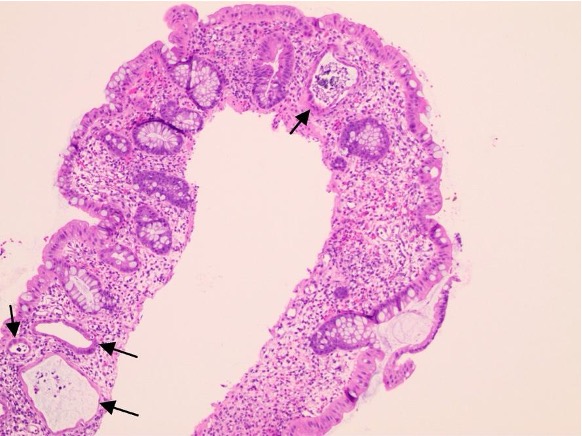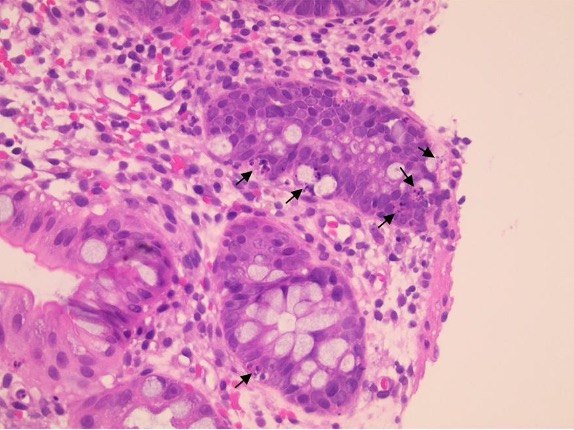Monday Poster Session
Category: Colon
P2500 - A Case of Mycophenolate Mofetil-Induced Colitis in a Patient With Lupus Nephritis
Monday, October 27, 2025
10:30 AM - 4:00 PM PDT
Location: Exhibit Hall

Edwin I. Mendoza, MD
Texas Tech University Health Sciences Center
El Paso, TX
Presenting Author(s)
Edwin I. Mendoza, MD1, Kunal Sharma, MD1, Lakshmi Kattamuri, MD1, Shivangini Duggal, MD2, Venkata Abhilash Muthineni, MD1, Aimee Hechanova, MD1, Abhizith Deoker, MD1
1Texas Tech University Health Sciences Center, El Paso, TX; 2Department of Internal Medicine at Paul L. Foster School of Medicine, Texas Tech University Health Sciences Center, El Paso TX, USA, El Paso, TX
Introduction: Mycophenolate mofetil (MMF) is a potent immunosuppressive agent widely used in therapeutic regimens for autoimmune conditions, such as systemic lupus erythematosus (SLE) and myasthenia gravis, as well as in post-solid organ transplant periods to counter allogenic graft rejection. MMF-induced colitis is a serious complication seen in post-transplant patients on chronic immunosuppression but infrequently reported in autoimmune disorders. Here we present a case of a young female with SLE and active lupus nephritis presenting with MMF-induced colitis.
Case Description/
Methods: A woman in her twenties with a known history of systemic lupus erythematosus (SLE) was sent from the nephrology clinic to the emergency department with progressive anasarca, nausea, pruritus, and chronic diarrhea for the past six weeks. She was treated with high-dose glucocorticoids and an intensified dose of mycophenolate mofetil (MMF), which was increased from 250 mg twice daily to 1000 mg three times daily (3 grams/day) as induction therapy for a flare of biopsy confirmed lupus nephritis, with partial improvement in renal function. She continued to experience increasingly frequent diarrheal episodes (up to 10 times a day), two weeks after increasing the dose of MMF. She reported passing large volume, watery, non-greasy, and non-foul-smelling loose stools, without gross admixture of blood, mucus, or pus. The stool workup was positive for the guaiac test but otherwise negative for infectious etiologies. Biopsies taken from the ascending colon, transverse colon, and sigmoid colon revealed fragments of benign colonic mucosa demonstrating pathologic features consistent with mycophenolate mofetil toxicity.
Discussion: Mycophenolate mofetil (MMF) is widely used as an induction agent for lupus nephritis due to its immunosuppressive efficacy and a relatively acceptable toxicity profile. MMF has been shown to reduce the steroid requirement and the number of subsequent disease flares. However, gastrointestinal side effects, particularly diarrhea and colitis, are more commonly observed with MMF. Given that MMF-induced colitis can closely mimic conditions such as inflammatory bowel disease (IBD) or graft-versus-host disease (GVHD), it is essential to pursue diagnostic evaluation, particularly colonoscopy with biopsies, to exclude these ‘mimics’ or coexisting pathologies. Simply discontinuing MMF without a thorough investigation may be inappropriate or even unsafe in cases where active IBD or GVHD is a diagnostic consideration.

Figure: Figure 1. Colonic mucosa showing atrophy and gland drop out. Some of the glands show withering (arrows) and are on the way to vanish. H&E stain, original magnification x 100.

Figure: Figure 2. Several glands show apoptosis (arrows). H&E stain, original magnification x 400.
Disclosures:
Edwin Mendoza indicated no relevant financial relationships.
Kunal Sharma indicated no relevant financial relationships.
Lakshmi Kattamuri indicated no relevant financial relationships.
Shivangini Duggal indicated no relevant financial relationships.
Venkata Abhilash Muthineni indicated no relevant financial relationships.
Aimee Hechanova indicated no relevant financial relationships.
Abhizith Deoker indicated no relevant financial relationships.
Edwin I. Mendoza, MD1, Kunal Sharma, MD1, Lakshmi Kattamuri, MD1, Shivangini Duggal, MD2, Venkata Abhilash Muthineni, MD1, Aimee Hechanova, MD1, Abhizith Deoker, MD1. P2500 - A Case of Mycophenolate Mofetil-Induced Colitis in a Patient With Lupus Nephritis, ACG 2025 Annual Scientific Meeting Abstracts. Phoenix, AZ: American College of Gastroenterology.
1Texas Tech University Health Sciences Center, El Paso, TX; 2Department of Internal Medicine at Paul L. Foster School of Medicine, Texas Tech University Health Sciences Center, El Paso TX, USA, El Paso, TX
Introduction: Mycophenolate mofetil (MMF) is a potent immunosuppressive agent widely used in therapeutic regimens for autoimmune conditions, such as systemic lupus erythematosus (SLE) and myasthenia gravis, as well as in post-solid organ transplant periods to counter allogenic graft rejection. MMF-induced colitis is a serious complication seen in post-transplant patients on chronic immunosuppression but infrequently reported in autoimmune disorders. Here we present a case of a young female with SLE and active lupus nephritis presenting with MMF-induced colitis.
Case Description/
Methods: A woman in her twenties with a known history of systemic lupus erythematosus (SLE) was sent from the nephrology clinic to the emergency department with progressive anasarca, nausea, pruritus, and chronic diarrhea for the past six weeks. She was treated with high-dose glucocorticoids and an intensified dose of mycophenolate mofetil (MMF), which was increased from 250 mg twice daily to 1000 mg three times daily (3 grams/day) as induction therapy for a flare of biopsy confirmed lupus nephritis, with partial improvement in renal function. She continued to experience increasingly frequent diarrheal episodes (up to 10 times a day), two weeks after increasing the dose of MMF. She reported passing large volume, watery, non-greasy, and non-foul-smelling loose stools, without gross admixture of blood, mucus, or pus. The stool workup was positive for the guaiac test but otherwise negative for infectious etiologies. Biopsies taken from the ascending colon, transverse colon, and sigmoid colon revealed fragments of benign colonic mucosa demonstrating pathologic features consistent with mycophenolate mofetil toxicity.
Discussion: Mycophenolate mofetil (MMF) is widely used as an induction agent for lupus nephritis due to its immunosuppressive efficacy and a relatively acceptable toxicity profile. MMF has been shown to reduce the steroid requirement and the number of subsequent disease flares. However, gastrointestinal side effects, particularly diarrhea and colitis, are more commonly observed with MMF. Given that MMF-induced colitis can closely mimic conditions such as inflammatory bowel disease (IBD) or graft-versus-host disease (GVHD), it is essential to pursue diagnostic evaluation, particularly colonoscopy with biopsies, to exclude these ‘mimics’ or coexisting pathologies. Simply discontinuing MMF without a thorough investigation may be inappropriate or even unsafe in cases where active IBD or GVHD is a diagnostic consideration.

Figure: Figure 1. Colonic mucosa showing atrophy and gland drop out. Some of the glands show withering (arrows) and are on the way to vanish. H&E stain, original magnification x 100.

Figure: Figure 2. Several glands show apoptosis (arrows). H&E stain, original magnification x 400.
Disclosures:
Edwin Mendoza indicated no relevant financial relationships.
Kunal Sharma indicated no relevant financial relationships.
Lakshmi Kattamuri indicated no relevant financial relationships.
Shivangini Duggal indicated no relevant financial relationships.
Venkata Abhilash Muthineni indicated no relevant financial relationships.
Aimee Hechanova indicated no relevant financial relationships.
Abhizith Deoker indicated no relevant financial relationships.
Edwin I. Mendoza, MD1, Kunal Sharma, MD1, Lakshmi Kattamuri, MD1, Shivangini Duggal, MD2, Venkata Abhilash Muthineni, MD1, Aimee Hechanova, MD1, Abhizith Deoker, MD1. P2500 - A Case of Mycophenolate Mofetil-Induced Colitis in a Patient With Lupus Nephritis, ACG 2025 Annual Scientific Meeting Abstracts. Phoenix, AZ: American College of Gastroenterology.
